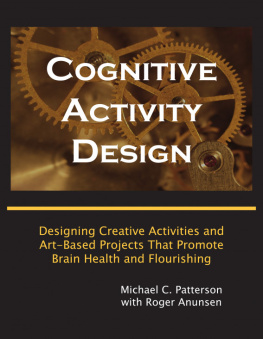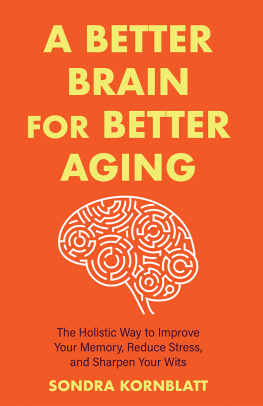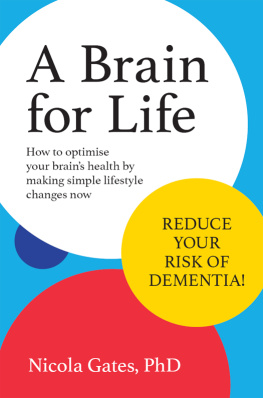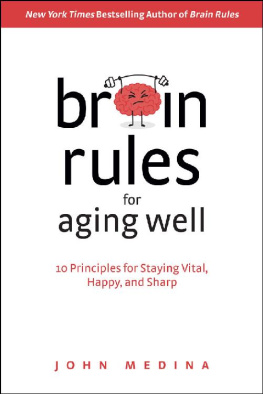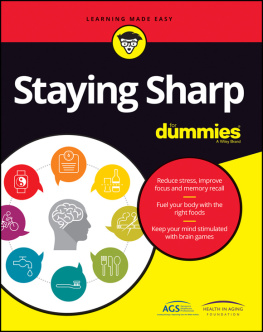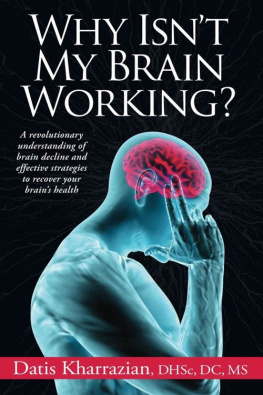Strong Brains, SharpMinds
The Definitive Guide to theMINDRAMP Method
For Brain Health &Mental Development
By Michael C.Patterson
With RogerAnunsen
Published by MINDRAMPCONSULTING at Smashwords
Copyright 2015 (UpdatedJanuary, 2017) Michael C. Patterson
Smashwords Edition, LicenseNotes
This eBook is licensed foryour personal enjoyment only and may not be re-sold or shared.Please purchase an individual copy for each reader of this book atSmashwords.com. Thank you for respecting the hard work of theauthors and help us maintain the low cost of the eBooks.
Cover design by JillianPatterson
Strong Brains, Sharp Minds(SBSM) is a brain health sourcebook for gerontologists andgerontology students.
SBSM is built around a number of importantideas that suggest new roles and responsibilities for the field ofgerontology.
~ First, the study of gerontology -the study of the social, psychological and biological aspects ofaging - must include the study of the brain and how it changes overthe course of a long lifetime.
~ Second, Gerontology needs tostudy the impact of increased longevity . The human species isexperiencing a remarkable extension of expected lifespan. Many moreof us are living remarkably long lives. Some of us flourish intoour nineties and beyond. Others suffer extended periods of declineand suffering. The study of gerontology should help people flourishthroughout their long lives.
~ Third, the expanded vision forGerontology should be relevant to people of all ages. The study ofaging need not confine itself to old people. We age from the momentof conception. Aging is a lifelong activity. The way we handleaging in our youthful years shapes the way we will age when old.Gerontology should encourage us to prepare well for a longlife.
With these points inmind, Strong Brains, SharpMinds , offers students of gerontology athorough review of the dynamics of brain health. The book isdivided into two main sections.
The first section providesan overview of the science of brain health. It examines thetrajectory of our cognitive abilities over the course of alifetime. We present an argument that the enduring plasticity ofthe human brain offers us the opportunity to shape the structureand function of our brains. By managing risk factors and protectivefactors wisely we can make our brains stronger and more resilient.We can make our minds sharper and better able to achievequality-of-life across our lifespans.
The second section providesin-depth explorations of six key behavioral areas. Each of thesesix CogWheels of Brain Health have a profound effect on brainhealth and mental sharpness.
Section Two is a review ofMINDRAMPs six Essential CogWheels of Brain Health. We pulltogether a wealth of research on effective ways to promote brainhealth. The research is organized into six categories. They are: 1)physical exercise and movement; 2) mental stimulation; 3) socialinteraction; 4) stress management; 5) diet and nutrition; and 6)sleep. The six CogWheels are the cornerstones of the MINDRAMPapproach to brain health.
Strong Brains, SharpMinds provides practicing gerontologistsand gerontology students with the foundational concepts you need tointegrate brain health into all aspects of your work.
Table ofContents
Good Wolves & BadWolves
Your Plastic Brain;Qualongevity; The RAMP Analogy; How The Book isOrganized.
~ How Old Are You? ~ IsThere Evidence? ~ The Zone of Cognitive Function ~ Ms. Lucky andMr. Pitiful ~ Compression of Morbidity
~ The ProfessorLearns to Crawl ~ The Malleable Brain ~ Pedros Plastic Recovery ~The Mechanisms of Positive Plasticity ~ Epigenetics: More ThanGenes ~ Size Matters: Plasticity and Brain Size ~ NeuroplasticHealing ~ The Positive Plasticity Premise ~ Ramping Up PositivePlasticity.
~ The Nun Study ~ Types ofReserve ~ Passive Reserve ~ Active Reserve ~ The Reserve Theory:The Evidence ~ Building brain reserve
~ Nature, nurture & risk factors ~ Riskfactors for cognitive decline ~ What puts our brains at risk? ~Categories of risk factors ~ A cascade of insults and injuries ~The problems with diagnosing Alzheimers. ~ Can we reduce dementiaby limiting exposure to risk factors? ~ Individual actions toreduce risk factors. ~ Societal actions to reduce riskfactors
Embracing the Benefits of Stress ~ AttitudesAbout Stress ~ A Note About Stress Hormones ~ A Stress MindsetReset ~ Peak Levels of Stress ~ Stress: The Good, The Bad, TheBenign ~ Stress and diseases of slow accumulation ~ Stress - Past,Future & Present ~ Stress and the past ~ Stress and the future~ Stress and the present ~ The physiology of the stress response ~Allostasis and allostatic load ~ The HPA axis ~ The autonomicnervous system ~ Problems related to chronic stress ~ ManagingStress 2.0 ~ Managing Stress 1.0 ~ Approaches to stress management~ Meditation ~ Mindfulness ~ Flow ~ Social support.
A Snapshot ~ Movement ~Body/Brain Interaction ~ Embodied Cognition ~ Benefits of Movement& Physical Activity ~ Stress & Depression ~CognitiveCapacity ~ Neurogenesis ~ Production of BDNF ~ Stimulation ofLearning & ~ Memory ~ Mood Enhancement & Regulation ~Cardiovascular Health ~ Cholesterol ~ Regulation ~ Control of BloodGlucose Levels ~ Mitochondria Growth ~ Enhanced Waste Disposal ~Epigenetic Changes ~ Exercise Levels: Intensity & Duration ~Multi-factorial, Combinatorial Exercise ~ A word of caution - Can exercise have negativeeffects?
A Snapshot: What Kind of Mental Stimulation~ Enriched Environments ~ Leisure Activities ~ Education ~ Literacyand Reading ~ Complex Work Activities ~ Risks and Protections ~ ThePower of Mindsets ~ Negative & Positive Mindsets ~ OptimizingYour Mind ~ Thinking Fast and Slow ~ Meditation ~ Mindset Rests ~ AMastery Continuum ~ Creative Thinking ~ The CreativeCycle ~ Stress,Learning & Creativity.
A Snapshot ~ We Are Social Animals ~ SocialDrivers of Human Evolution ~ The Evolution of Social Engagement ~Narrow Hips and Enlarged Brains ~ Rapid and Prolonged BrainDevelopment; Slow Body Development ~ Cooperative Child-Rearing ~Lifelong Learning and Development ~ The Neotony of MentalDevelopment in Humans ~ Social Learning ~ Social Cooperation ~Social Networks ~ Negative Social Interaction ~ When SocialInteraction is Absent ~ Physical Isolation ~ Emotional Isolation ~Social Status ~ Abusive Relationships ~ Distress and the HPA Axis ~Social Determinants of Health ~ Control of the Situation ~ WhatKind of Social Engagement Affects Brain Health?
A Snapshot of Ingestion ~What W e Ingest ~The Mood Altering Effects of What We Ingest ~ Chimpanzees and theWestern Diet ~ Diet & Disease ~ Obesity ~ Diabetes ~ The Guestsin Our Guts ~ Bacterial Diversity ~ Antibiotics ~ Fiber ~ OurMicrobiota ~ Breast Milk andBifidobacterium ~ Epithelium ~ The Micribiota and Diabetes ~ Gut Health Advice ~ What Foods are Good For OurBrains?
A Snapshot ~ Why Is Sleep One of the EssentialCogWheels? ~ What is Sleep? ~ How DoesSleep Contribute to Brain Health? ~ Memory Consolidation ~ The Synaptic Homeostasis Hypothesis ~ Waste Removal DuringSleep ~ Sleep,Cognitive Decline and Dementia ~ Sleep& Beta Amyloid ~ Sleep DeprivationLeads to Cognitive Decline and Dementia ~ Is Sleep Disturbance a Risk Factorfor Dementia, or Does Dementia Cause Sleep Problems? ~ Sleep Disorders ~ SleepDeprivation ~ Insomnia ~ Obstructive Sleep Apnea ~ General Sleep Recommendations ~ How Much Sleep Should We Get EachNight? ~ Sleep Hygiene ~ Mental Rest ~Meditation
Can We Improve Brain Health? ~ Staying Sharp~ Mismatch Diseases ~ Risk Management ~ Focus on Causes Not Cures ~Combinatorial Approaches ~ Putting Risk Management Into Action.
Closing Thoughts
Acknowledgments ~ Index of Key Terms, Peopleand Publications
PREFACE
Good Wolves & Bad Wolves
You may have heard thelegend a Cherokee elder who was known for her wisdom, happiness andpeace of mind. Ayounger member of the tribe comes to the elder and asks her, Howhave you come to be so happy, wise and respected by all in ourtribe? A gentle smile spreads across the wise womans face as sheanswers that there are two packs of wolves that fight for dominancewithin in her heart and mind. One pack are the wolves of love andwisdom; the other pack the wolves of hatred, greed anddelusion.
Next page

